Marketing Analysis of Tesco Plc: Strategies, Frameworks, and Branding
VerifiedAdded on 2021/04/21
|25
|6120
|49
Report
AI Summary
This report provides a comprehensive analysis of Tesco's marketing strategies, examining its current approaches, marketing mix elements, and financial performance. It delves into the application of marketing frameworks such as the Aaker and Keller models to understand Tesco's brand equity and customer-based branding. The report explores Tesco's international marketing strategies, including its expansion into various global markets and the adaptation versus standardization of its marketing mix. It also covers key terms related to branding and international marketing. Furthermore, the report provides an overview of Tesco's objectives, including maximizing sales, reducing costs, and contributing to the community. The analysis includes a review of Tesco's marketing campaigns, digital channels, and the company's approach to localization and decentralization in international markets. Overall, the report offers valuable insights into Tesco's marketing practices and its ability to navigate the complexities of the retail industry.
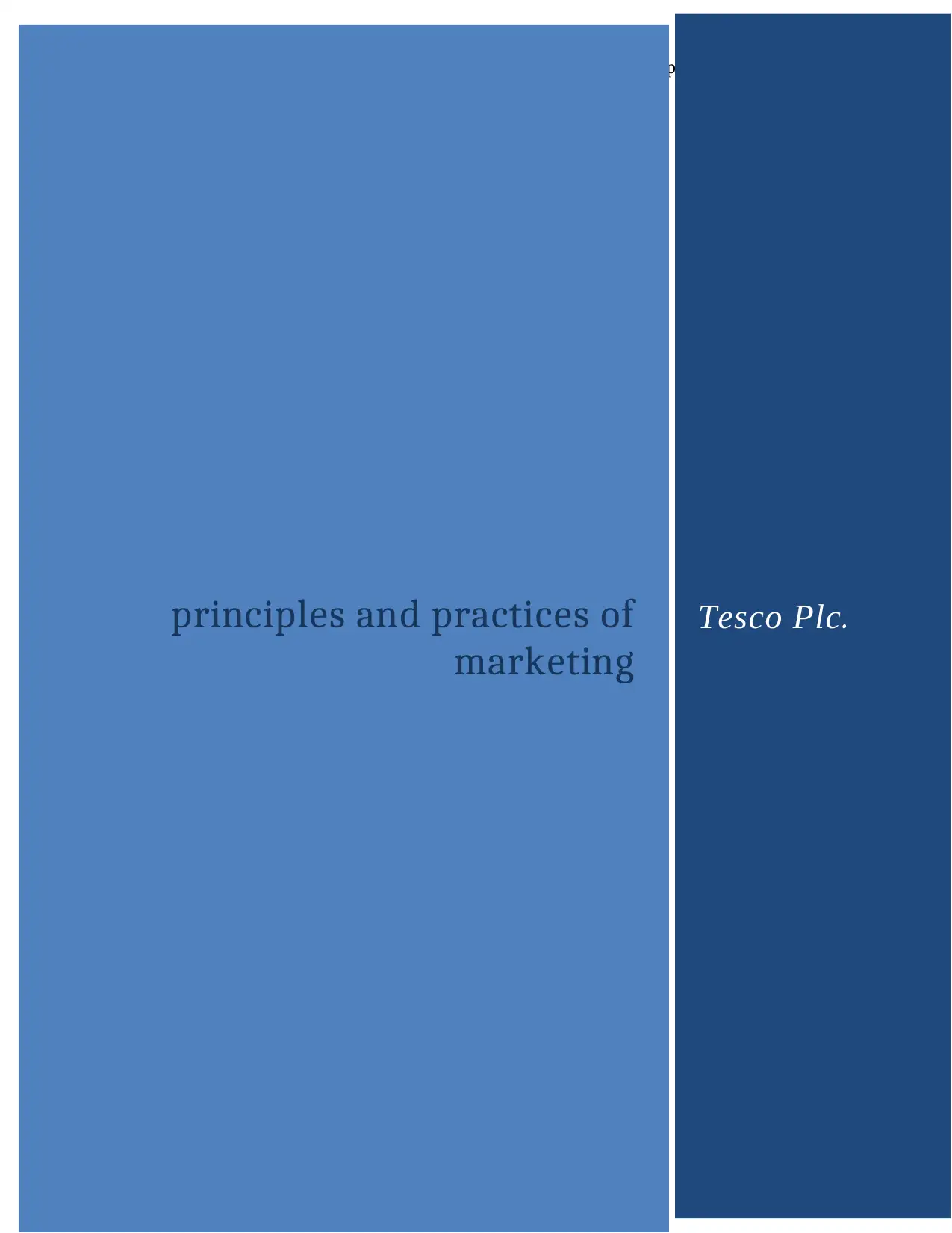
Principles and practice of marketing 1
pr
principles and practices of
marketing
Tesco Plc.
pr
principles and practices of
marketing
Tesco Plc.
Paraphrase This Document
Need a fresh take? Get an instant paraphrase of this document with our AI Paraphraser
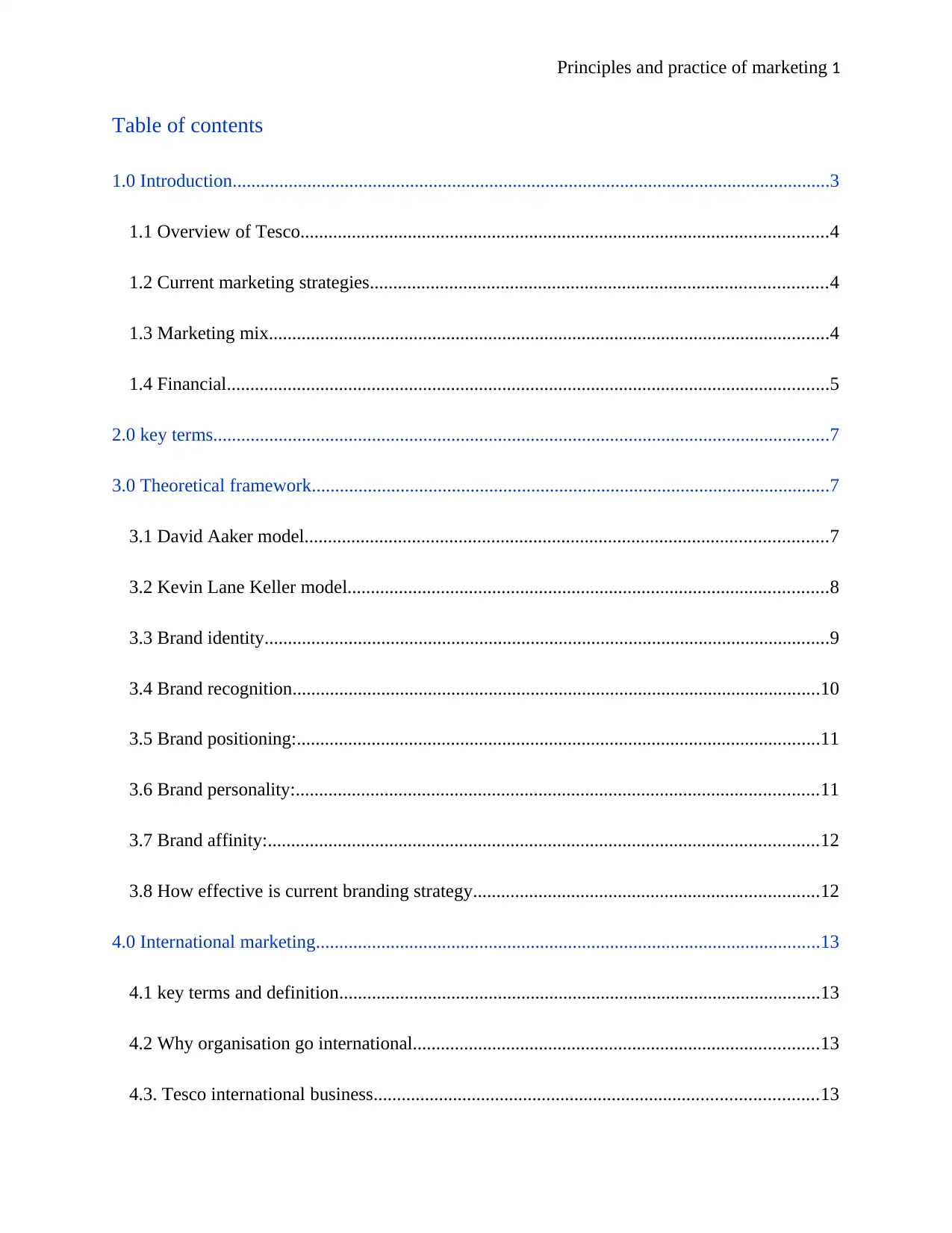
Principles and practice of marketing 1
Table of contents
1.0 Introduction................................................................................................................................3
1.1 Overview of Tesco.................................................................................................................4
1.2 Current marketing strategies..................................................................................................4
1.3 Marketing mix........................................................................................................................4
1.4 Financial.................................................................................................................................5
2.0 key terms....................................................................................................................................7
3.0 Theoretical framework...............................................................................................................7
3.1 David Aaker model................................................................................................................7
3.2 Kevin Lane Keller model.......................................................................................................8
3.3 Brand identity.........................................................................................................................9
3.4 Brand recognition.................................................................................................................10
3.5 Brand positioning:................................................................................................................11
3.6 Brand personality:................................................................................................................11
3.7 Brand affinity:......................................................................................................................12
3.8 How effective is current branding strategy..........................................................................12
4.0 International marketing............................................................................................................13
4.1 key terms and definition.......................................................................................................13
4.2 Why organisation go international.......................................................................................13
4.3. Tesco international business...............................................................................................13
Table of contents
1.0 Introduction................................................................................................................................3
1.1 Overview of Tesco.................................................................................................................4
1.2 Current marketing strategies..................................................................................................4
1.3 Marketing mix........................................................................................................................4
1.4 Financial.................................................................................................................................5
2.0 key terms....................................................................................................................................7
3.0 Theoretical framework...............................................................................................................7
3.1 David Aaker model................................................................................................................7
3.2 Kevin Lane Keller model.......................................................................................................8
3.3 Brand identity.........................................................................................................................9
3.4 Brand recognition.................................................................................................................10
3.5 Brand positioning:................................................................................................................11
3.6 Brand personality:................................................................................................................11
3.7 Brand affinity:......................................................................................................................12
3.8 How effective is current branding strategy..........................................................................12
4.0 International marketing............................................................................................................13
4.1 key terms and definition.......................................................................................................13
4.2 Why organisation go international.......................................................................................13
4.3. Tesco international business...............................................................................................13
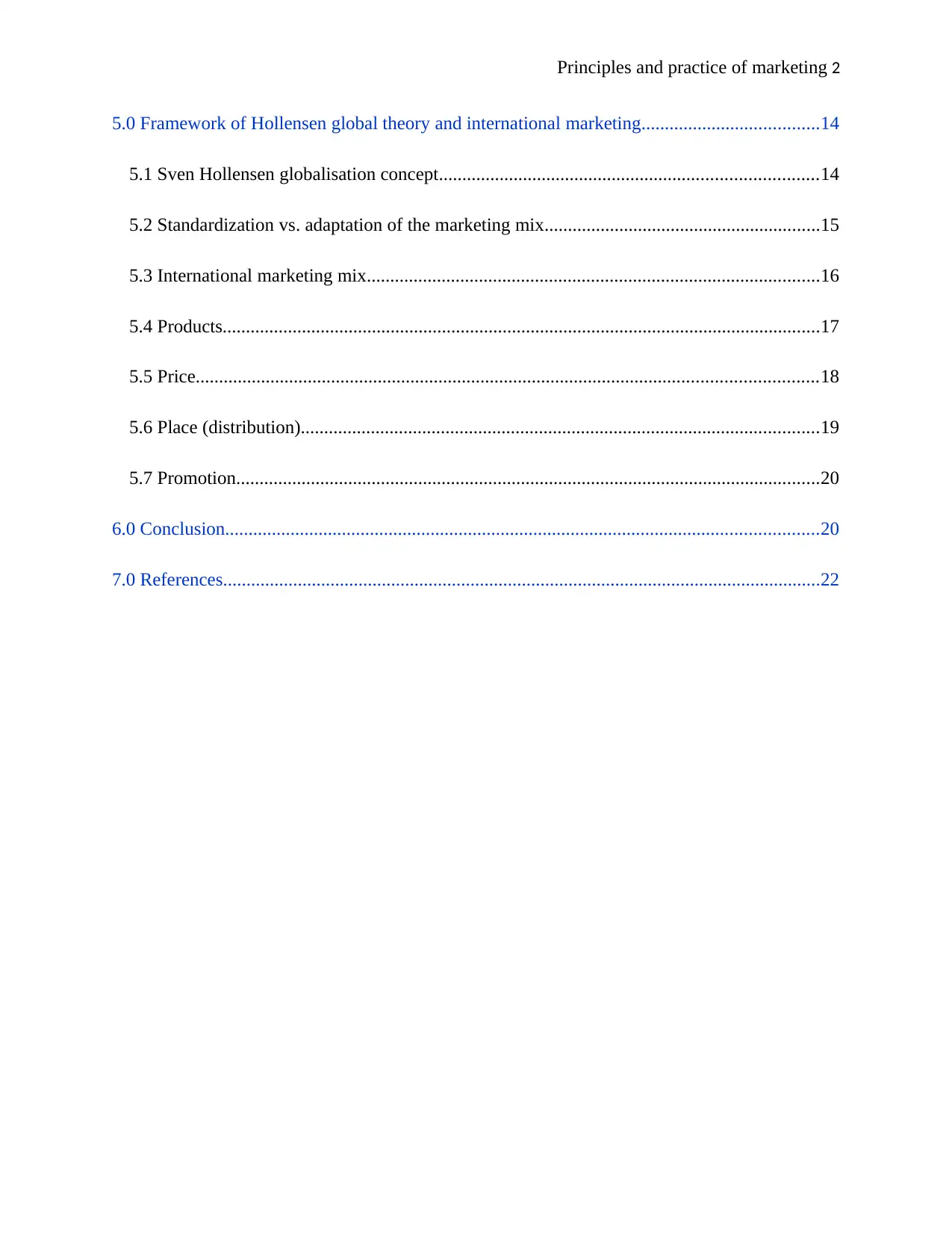
Principles and practice of marketing 2
5.0 Framework of Hollensen global theory and international marketing......................................14
5.1 Sven Hollensen globalisation concept.................................................................................14
5.2 Standardization vs. adaptation of the marketing mix...........................................................15
5.3 International marketing mix.................................................................................................16
5.4 Products................................................................................................................................17
5.5 Price.....................................................................................................................................18
5.6 Place (distribution)...............................................................................................................19
5.7 Promotion.............................................................................................................................20
6.0 Conclusion...............................................................................................................................20
7.0 References................................................................................................................................22
5.0 Framework of Hollensen global theory and international marketing......................................14
5.1 Sven Hollensen globalisation concept.................................................................................14
5.2 Standardization vs. adaptation of the marketing mix...........................................................15
5.3 International marketing mix.................................................................................................16
5.4 Products................................................................................................................................17
5.5 Price.....................................................................................................................................18
5.6 Place (distribution)...............................................................................................................19
5.7 Promotion.............................................................................................................................20
6.0 Conclusion...............................................................................................................................20
7.0 References................................................................................................................................22
⊘ This is a preview!⊘
Do you want full access?
Subscribe today to unlock all pages.

Trusted by 1+ million students worldwide
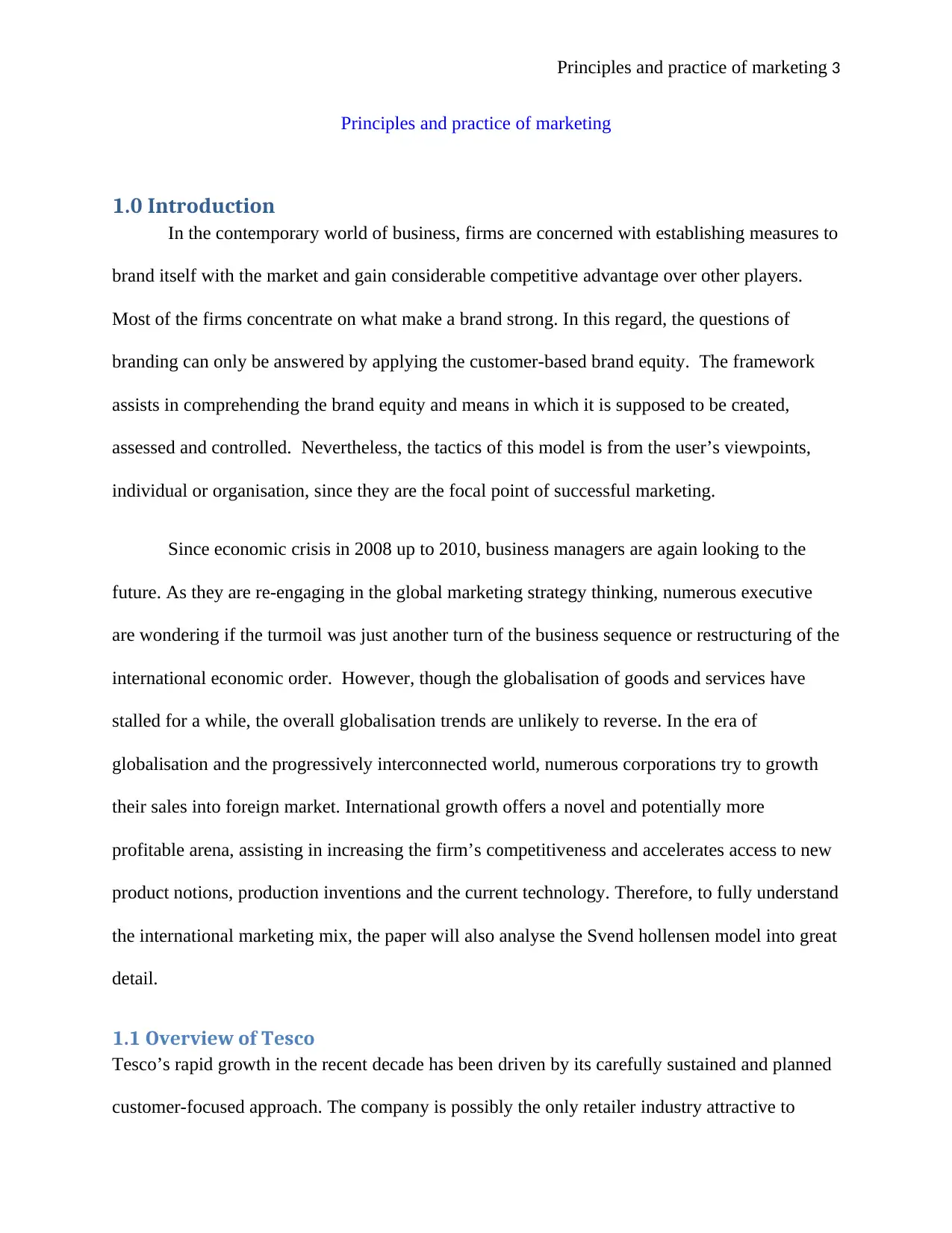
Principles and practice of marketing 3
Principles and practice of marketing
1.0 Introduction
In the contemporary world of business, firms are concerned with establishing measures to
brand itself with the market and gain considerable competitive advantage over other players.
Most of the firms concentrate on what make a brand strong. In this regard, the questions of
branding can only be answered by applying the customer-based brand equity. The framework
assists in comprehending the brand equity and means in which it is supposed to be created,
assessed and controlled. Nevertheless, the tactics of this model is from the user’s viewpoints,
individual or organisation, since they are the focal point of successful marketing.
Since economic crisis in 2008 up to 2010, business managers are again looking to the
future. As they are re-engaging in the global marketing strategy thinking, numerous executive
are wondering if the turmoil was just another turn of the business sequence or restructuring of the
international economic order. However, though the globalisation of goods and services have
stalled for a while, the overall globalisation trends are unlikely to reverse. In the era of
globalisation and the progressively interconnected world, numerous corporations try to growth
their sales into foreign market. International growth offers a novel and potentially more
profitable arena, assisting in increasing the firm’s competitiveness and accelerates access to new
product notions, production inventions and the current technology. Therefore, to fully understand
the international marketing mix, the paper will also analyse the Svend hollensen model into great
detail.
1.1 Overview of Tesco
Tesco’s rapid growth in the recent decade has been driven by its carefully sustained and planned
customer-focused approach. The company is possibly the only retailer industry attractive to
Principles and practice of marketing
1.0 Introduction
In the contemporary world of business, firms are concerned with establishing measures to
brand itself with the market and gain considerable competitive advantage over other players.
Most of the firms concentrate on what make a brand strong. In this regard, the questions of
branding can only be answered by applying the customer-based brand equity. The framework
assists in comprehending the brand equity and means in which it is supposed to be created,
assessed and controlled. Nevertheless, the tactics of this model is from the user’s viewpoints,
individual or organisation, since they are the focal point of successful marketing.
Since economic crisis in 2008 up to 2010, business managers are again looking to the
future. As they are re-engaging in the global marketing strategy thinking, numerous executive
are wondering if the turmoil was just another turn of the business sequence or restructuring of the
international economic order. However, though the globalisation of goods and services have
stalled for a while, the overall globalisation trends are unlikely to reverse. In the era of
globalisation and the progressively interconnected world, numerous corporations try to growth
their sales into foreign market. International growth offers a novel and potentially more
profitable arena, assisting in increasing the firm’s competitiveness and accelerates access to new
product notions, production inventions and the current technology. Therefore, to fully understand
the international marketing mix, the paper will also analyse the Svend hollensen model into great
detail.
1.1 Overview of Tesco
Tesco’s rapid growth in the recent decade has been driven by its carefully sustained and planned
customer-focused approach. The company is possibly the only retailer industry attractive to
Paraphrase This Document
Need a fresh take? Get an instant paraphrase of this document with our AI Paraphraser
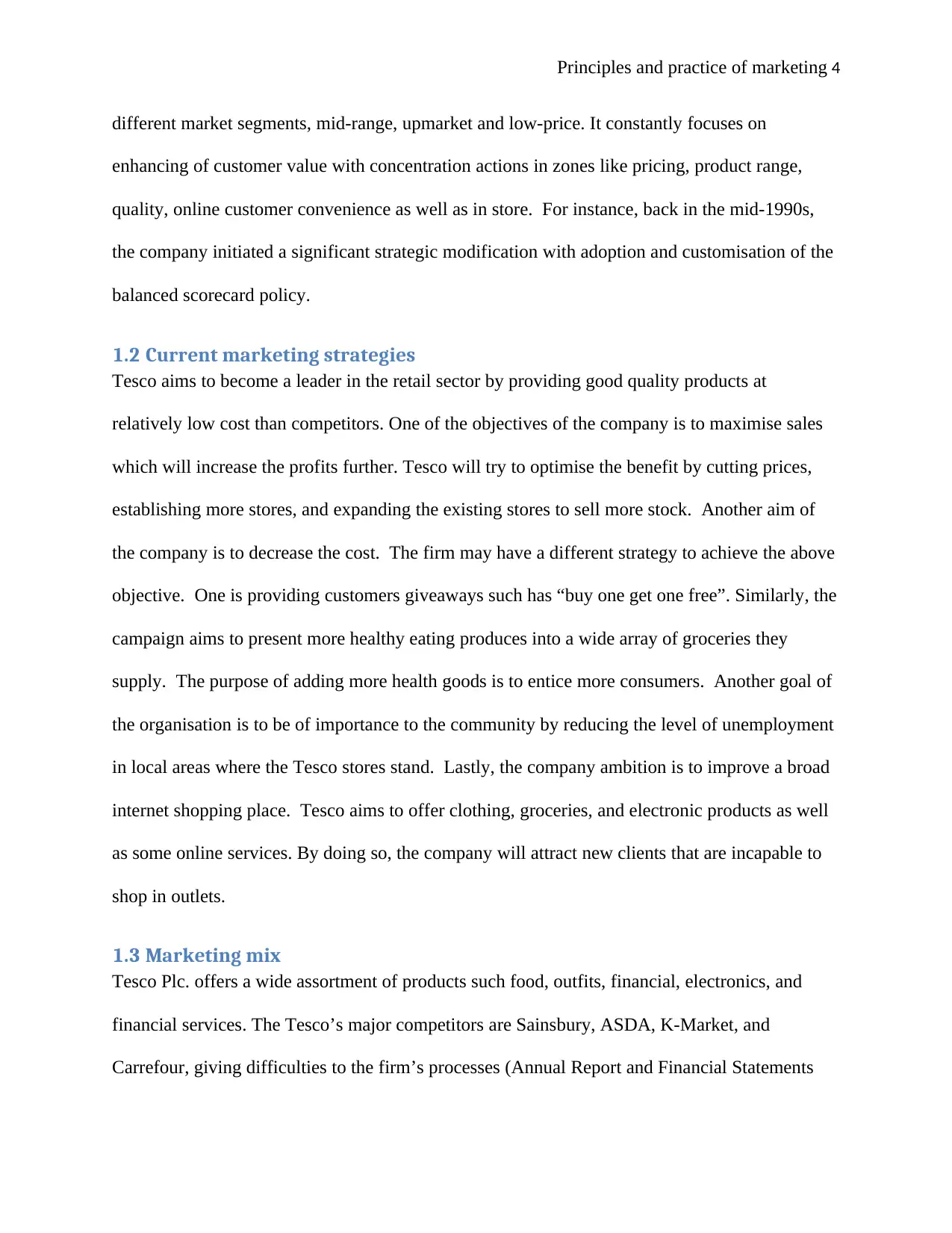
Principles and practice of marketing 4
different market segments, mid-range, upmarket and low-price. It constantly focuses on
enhancing of customer value with concentration actions in zones like pricing, product range,
quality, online customer convenience as well as in store. For instance, back in the mid-1990s,
the company initiated a significant strategic modification with adoption and customisation of the
balanced scorecard policy.
1.2 Current marketing strategies
Tesco aims to become a leader in the retail sector by providing good quality products at
relatively low cost than competitors. One of the objectives of the company is to maximise sales
which will increase the profits further. Tesco will try to optimise the benefit by cutting prices,
establishing more stores, and expanding the existing stores to sell more stock. Another aim of
the company is to decrease the cost. The firm may have a different strategy to achieve the above
objective. One is providing customers giveaways such has “buy one get one free”. Similarly, the
campaign aims to present more healthy eating produces into a wide array of groceries they
supply. The purpose of adding more health goods is to entice more consumers. Another goal of
the organisation is to be of importance to the community by reducing the level of unemployment
in local areas where the Tesco stores stand. Lastly, the company ambition is to improve a broad
internet shopping place. Tesco aims to offer clothing, groceries, and electronic products as well
as some online services. By doing so, the company will attract new clients that are incapable to
shop in outlets.
1.3 Marketing mix
Tesco Plc. offers a wide assortment of products such food, outfits, financial, electronics, and
financial services. The Tesco’s major competitors are Sainsbury, ASDA, K-Market, and
Carrefour, giving difficulties to the firm’s processes (Annual Report and Financial Statements
different market segments, mid-range, upmarket and low-price. It constantly focuses on
enhancing of customer value with concentration actions in zones like pricing, product range,
quality, online customer convenience as well as in store. For instance, back in the mid-1990s,
the company initiated a significant strategic modification with adoption and customisation of the
balanced scorecard policy.
1.2 Current marketing strategies
Tesco aims to become a leader in the retail sector by providing good quality products at
relatively low cost than competitors. One of the objectives of the company is to maximise sales
which will increase the profits further. Tesco will try to optimise the benefit by cutting prices,
establishing more stores, and expanding the existing stores to sell more stock. Another aim of
the company is to decrease the cost. The firm may have a different strategy to achieve the above
objective. One is providing customers giveaways such has “buy one get one free”. Similarly, the
campaign aims to present more healthy eating produces into a wide array of groceries they
supply. The purpose of adding more health goods is to entice more consumers. Another goal of
the organisation is to be of importance to the community by reducing the level of unemployment
in local areas where the Tesco stores stand. Lastly, the company ambition is to improve a broad
internet shopping place. Tesco aims to offer clothing, groceries, and electronic products as well
as some online services. By doing so, the company will attract new clients that are incapable to
shop in outlets.
1.3 Marketing mix
Tesco Plc. offers a wide assortment of products such food, outfits, financial, electronics, and
financial services. The Tesco’s major competitors are Sainsbury, ASDA, K-Market, and
Carrefour, giving difficulties to the firm’s processes (Annual Report and Financial Statements
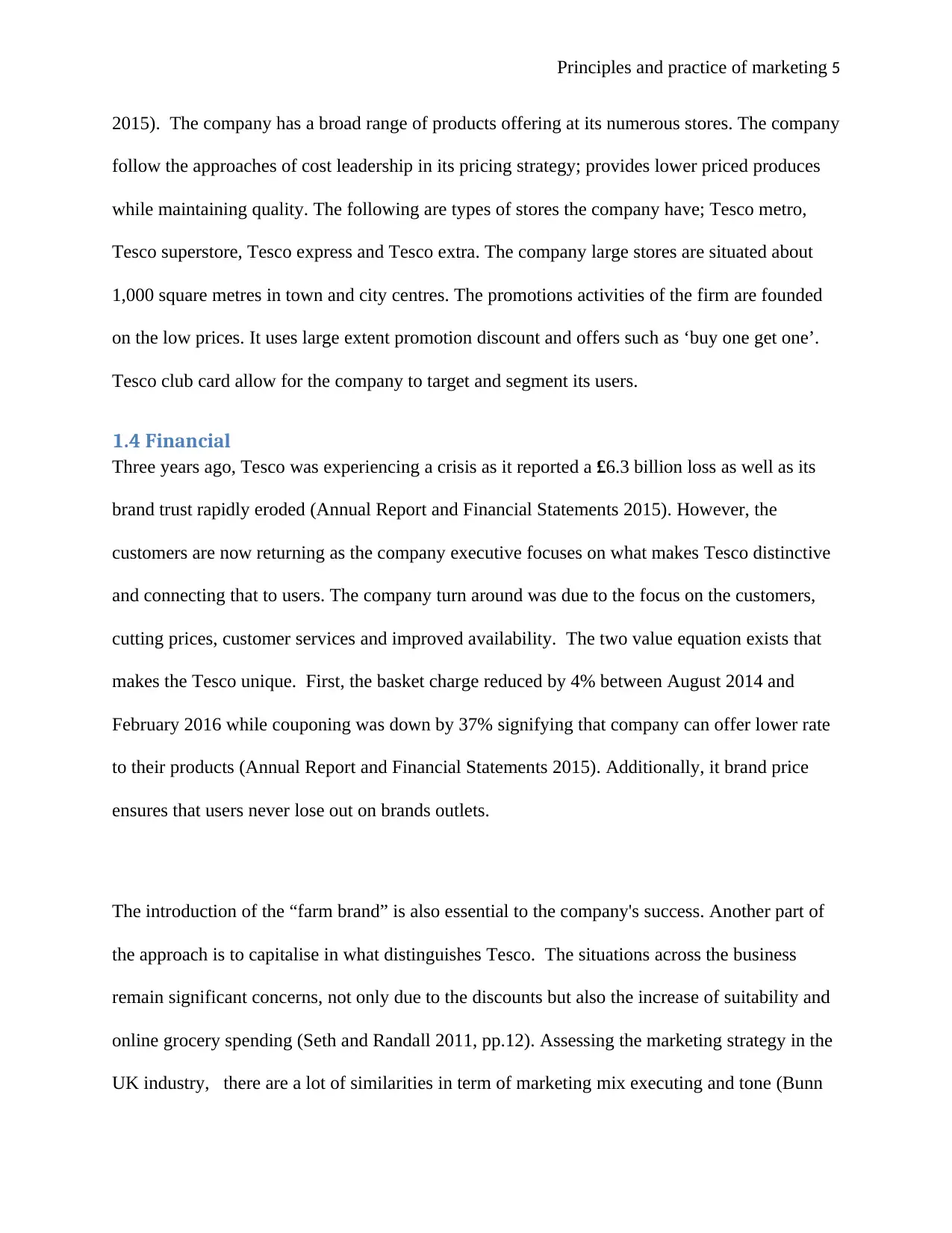
Principles and practice of marketing 5
2015). The company has a broad range of products offering at its numerous stores. The company
follow the approaches of cost leadership in its pricing strategy; provides lower priced produces
while maintaining quality. The following are types of stores the company have; Tesco metro,
Tesco superstore, Tesco express and Tesco extra. The company large stores are situated about
1,000 square metres in town and city centres. The promotions activities of the firm are founded
on the low prices. It uses large extent promotion discount and offers such as ‘buy one get one’.
Tesco club card allow for the company to target and segment its users.
1.4 Financial
Three years ago, Tesco was experiencing a crisis as it reported a £6.3 billion loss as well as its
brand trust rapidly eroded (Annual Report and Financial Statements 2015). However, the
customers are now returning as the company executive focuses on what makes Tesco distinctive
and connecting that to users. The company turn around was due to the focus on the customers,
cutting prices, customer services and improved availability. The two value equation exists that
makes the Tesco unique. First, the basket charge reduced by 4% between August 2014 and
February 2016 while couponing was down by 37% signifying that company can offer lower rate
to their products (Annual Report and Financial Statements 2015). Additionally, it brand price
ensures that users never lose out on brands outlets.
The introduction of the “farm brand” is also essential to the company's success. Another part of
the approach is to capitalise in what distinguishes Tesco. The situations across the business
remain significant concerns, not only due to the discounts but also the increase of suitability and
online grocery spending (Seth and Randall 2011, pp.12). Assessing the marketing strategy in the
UK industry, there are a lot of similarities in term of marketing mix executing and tone (Bunn
2015). The company has a broad range of products offering at its numerous stores. The company
follow the approaches of cost leadership in its pricing strategy; provides lower priced produces
while maintaining quality. The following are types of stores the company have; Tesco metro,
Tesco superstore, Tesco express and Tesco extra. The company large stores are situated about
1,000 square metres in town and city centres. The promotions activities of the firm are founded
on the low prices. It uses large extent promotion discount and offers such as ‘buy one get one’.
Tesco club card allow for the company to target and segment its users.
1.4 Financial
Three years ago, Tesco was experiencing a crisis as it reported a £6.3 billion loss as well as its
brand trust rapidly eroded (Annual Report and Financial Statements 2015). However, the
customers are now returning as the company executive focuses on what makes Tesco distinctive
and connecting that to users. The company turn around was due to the focus on the customers,
cutting prices, customer services and improved availability. The two value equation exists that
makes the Tesco unique. First, the basket charge reduced by 4% between August 2014 and
February 2016 while couponing was down by 37% signifying that company can offer lower rate
to their products (Annual Report and Financial Statements 2015). Additionally, it brand price
ensures that users never lose out on brands outlets.
The introduction of the “farm brand” is also essential to the company's success. Another part of
the approach is to capitalise in what distinguishes Tesco. The situations across the business
remain significant concerns, not only due to the discounts but also the increase of suitability and
online grocery spending (Seth and Randall 2011, pp.12). Assessing the marketing strategy in the
UK industry, there are a lot of similarities in term of marketing mix executing and tone (Bunn
⊘ This is a preview!⊘
Do you want full access?
Subscribe today to unlock all pages.

Trusted by 1+ million students worldwide
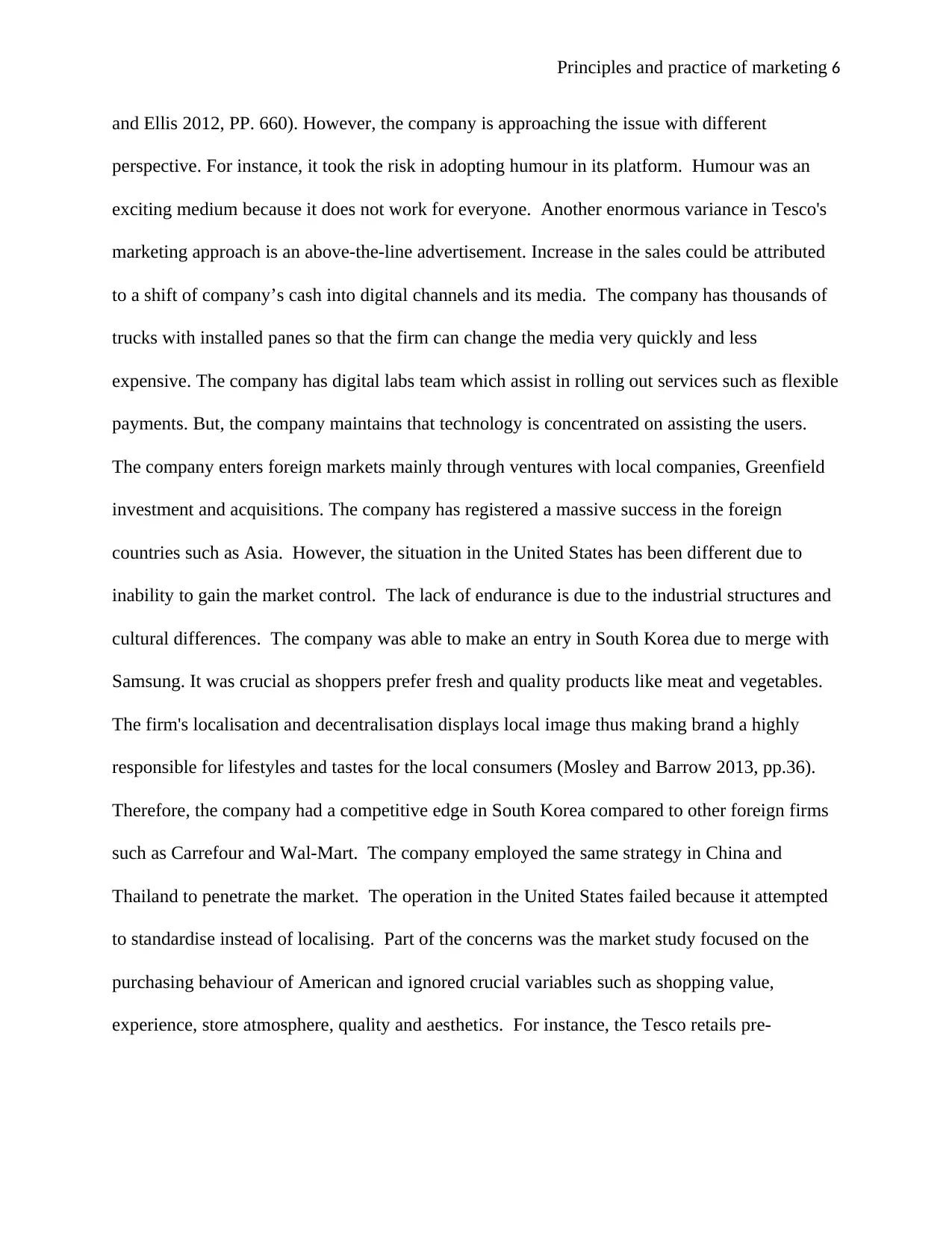
Principles and practice of marketing 6
and Ellis 2012, PP. 660). However, the company is approaching the issue with different
perspective. For instance, it took the risk in adopting humour in its platform. Humour was an
exciting medium because it does not work for everyone. Another enormous variance in Tesco's
marketing approach is an above-the-line advertisement. Increase in the sales could be attributed
to a shift of company’s cash into digital channels and its media. The company has thousands of
trucks with installed panes so that the firm can change the media very quickly and less
expensive. The company has digital labs team which assist in rolling out services such as flexible
payments. But, the company maintains that technology is concentrated on assisting the users.
The company enters foreign markets mainly through ventures with local companies, Greenfield
investment and acquisitions. The company has registered a massive success in the foreign
countries such as Asia. However, the situation in the United States has been different due to
inability to gain the market control. The lack of endurance is due to the industrial structures and
cultural differences. The company was able to make an entry in South Korea due to merge with
Samsung. It was crucial as shoppers prefer fresh and quality products like meat and vegetables.
The firm's localisation and decentralisation displays local image thus making brand a highly
responsible for lifestyles and tastes for the local consumers (Mosley and Barrow 2013, pp.36).
Therefore, the company had a competitive edge in South Korea compared to other foreign firms
such as Carrefour and Wal-Mart. The company employed the same strategy in China and
Thailand to penetrate the market. The operation in the United States failed because it attempted
to standardise instead of localising. Part of the concerns was the market study focused on the
purchasing behaviour of American and ignored crucial variables such as shopping value,
experience, store atmosphere, quality and aesthetics. For instance, the Tesco retails pre-
and Ellis 2012, PP. 660). However, the company is approaching the issue with different
perspective. For instance, it took the risk in adopting humour in its platform. Humour was an
exciting medium because it does not work for everyone. Another enormous variance in Tesco's
marketing approach is an above-the-line advertisement. Increase in the sales could be attributed
to a shift of company’s cash into digital channels and its media. The company has thousands of
trucks with installed panes so that the firm can change the media very quickly and less
expensive. The company has digital labs team which assist in rolling out services such as flexible
payments. But, the company maintains that technology is concentrated on assisting the users.
The company enters foreign markets mainly through ventures with local companies, Greenfield
investment and acquisitions. The company has registered a massive success in the foreign
countries such as Asia. However, the situation in the United States has been different due to
inability to gain the market control. The lack of endurance is due to the industrial structures and
cultural differences. The company was able to make an entry in South Korea due to merge with
Samsung. It was crucial as shoppers prefer fresh and quality products like meat and vegetables.
The firm's localisation and decentralisation displays local image thus making brand a highly
responsible for lifestyles and tastes for the local consumers (Mosley and Barrow 2013, pp.36).
Therefore, the company had a competitive edge in South Korea compared to other foreign firms
such as Carrefour and Wal-Mart. The company employed the same strategy in China and
Thailand to penetrate the market. The operation in the United States failed because it attempted
to standardise instead of localising. Part of the concerns was the market study focused on the
purchasing behaviour of American and ignored crucial variables such as shopping value,
experience, store atmosphere, quality and aesthetics. For instance, the Tesco retails pre-
Paraphrase This Document
Need a fresh take? Get an instant paraphrase of this document with our AI Paraphraser
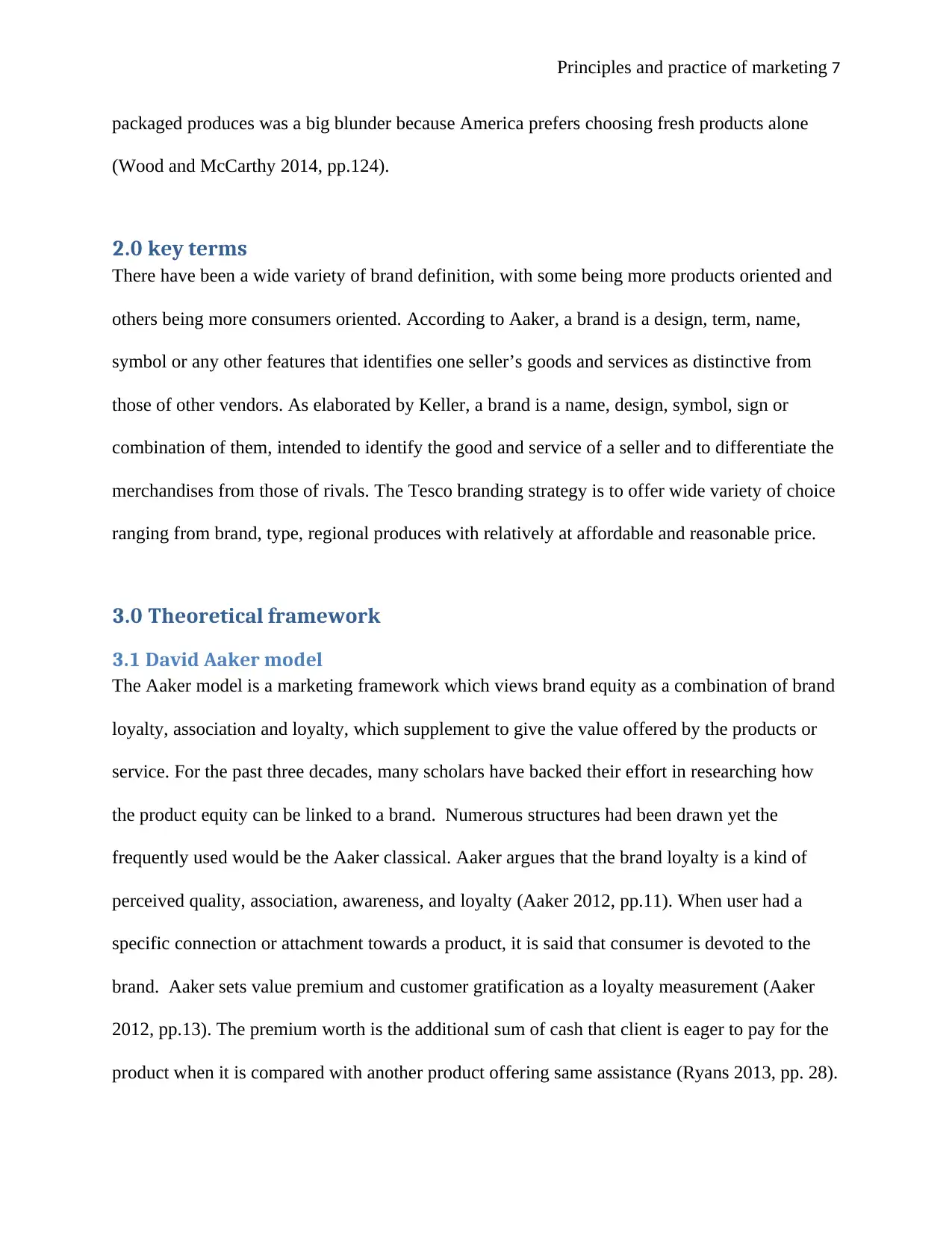
Principles and practice of marketing 7
packaged produces was a big blunder because America prefers choosing fresh products alone
(Wood and McCarthy 2014, pp.124).
2.0 key terms
There have been a wide variety of brand definition, with some being more products oriented and
others being more consumers oriented. According to Aaker, a brand is a design, term, name,
symbol or any other features that identifies one seller’s goods and services as distinctive from
those of other vendors. As elaborated by Keller, a brand is a name, design, symbol, sign or
combination of them, intended to identify the good and service of a seller and to differentiate the
merchandises from those of rivals. The Tesco branding strategy is to offer wide variety of choice
ranging from brand, type, regional produces with relatively at affordable and reasonable price.
3.0 Theoretical framework
3.1 David Aaker model
The Aaker model is a marketing framework which views brand equity as a combination of brand
loyalty, association and loyalty, which supplement to give the value offered by the products or
service. For the past three decades, many scholars have backed their effort in researching how
the product equity can be linked to a brand. Numerous structures had been drawn yet the
frequently used would be the Aaker classical. Aaker argues that the brand loyalty is a kind of
perceived quality, association, awareness, and loyalty (Aaker 2012, pp.11). When user had a
specific connection or attachment towards a product, it is said that consumer is devoted to the
brand. Aaker sets value premium and customer gratification as a loyalty measurement (Aaker
2012, pp.13). The premium worth is the additional sum of cash that client is eager to pay for the
product when it is compared with another product offering same assistance (Ryans 2013, pp. 28).
packaged produces was a big blunder because America prefers choosing fresh products alone
(Wood and McCarthy 2014, pp.124).
2.0 key terms
There have been a wide variety of brand definition, with some being more products oriented and
others being more consumers oriented. According to Aaker, a brand is a design, term, name,
symbol or any other features that identifies one seller’s goods and services as distinctive from
those of other vendors. As elaborated by Keller, a brand is a name, design, symbol, sign or
combination of them, intended to identify the good and service of a seller and to differentiate the
merchandises from those of rivals. The Tesco branding strategy is to offer wide variety of choice
ranging from brand, type, regional produces with relatively at affordable and reasonable price.
3.0 Theoretical framework
3.1 David Aaker model
The Aaker model is a marketing framework which views brand equity as a combination of brand
loyalty, association and loyalty, which supplement to give the value offered by the products or
service. For the past three decades, many scholars have backed their effort in researching how
the product equity can be linked to a brand. Numerous structures had been drawn yet the
frequently used would be the Aaker classical. Aaker argues that the brand loyalty is a kind of
perceived quality, association, awareness, and loyalty (Aaker 2012, pp.11). When user had a
specific connection or attachment towards a product, it is said that consumer is devoted to the
brand. Aaker sets value premium and customer gratification as a loyalty measurement (Aaker
2012, pp.13). The premium worth is the additional sum of cash that client is eager to pay for the
product when it is compared with another product offering same assistance (Ryans 2013, pp. 28).
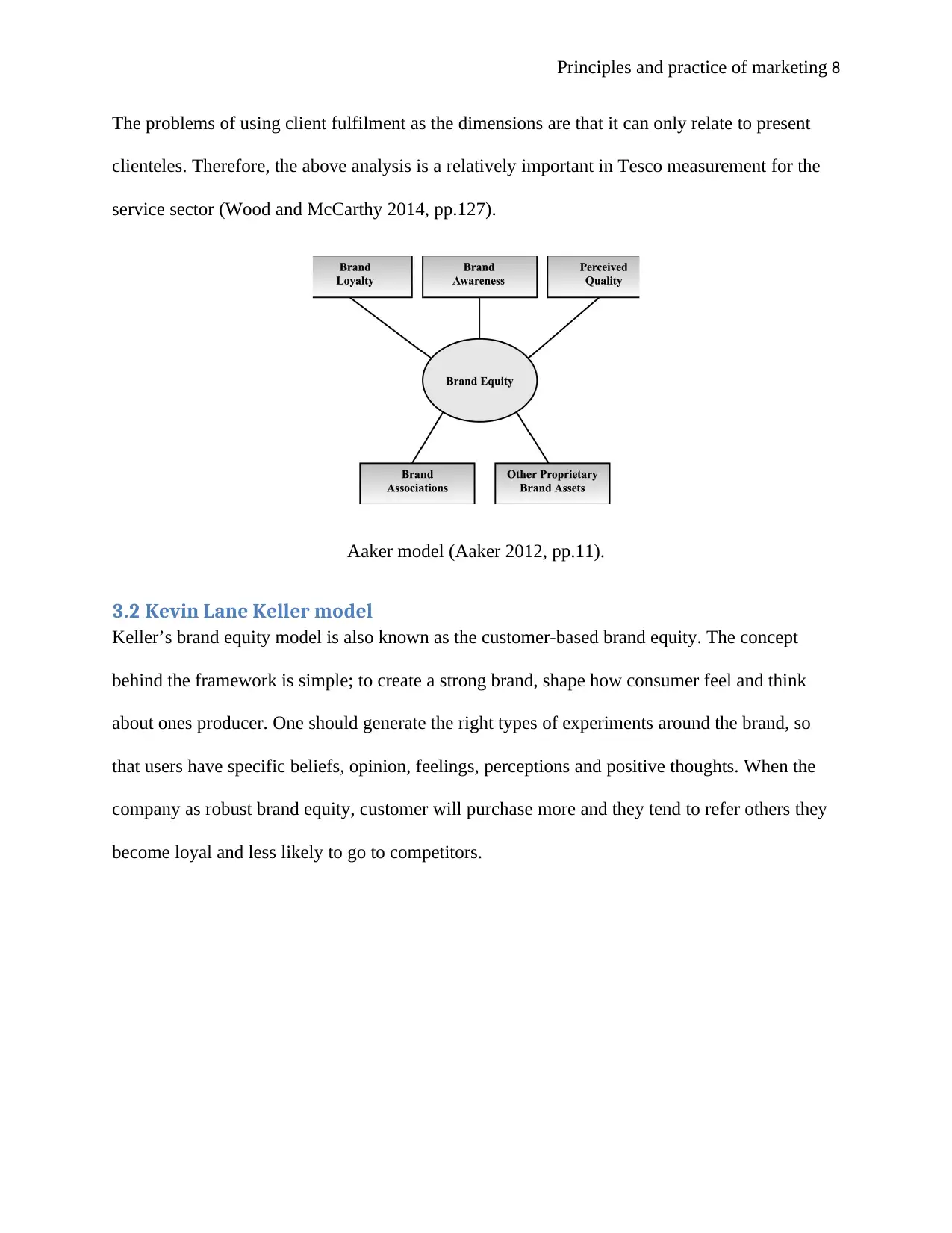
Principles and practice of marketing 8
The problems of using client fulfilment as the dimensions are that it can only relate to present
clienteles. Therefore, the above analysis is a relatively important in Tesco measurement for the
service sector (Wood and McCarthy 2014, pp.127).
Aaker model (Aaker 2012, pp.11).
3.2 Kevin Lane Keller model
Keller’s brand equity model is also known as the customer-based brand equity. The concept
behind the framework is simple; to create a strong brand, shape how consumer feel and think
about ones producer. One should generate the right types of experiments around the brand, so
that users have specific beliefs, opinion, feelings, perceptions and positive thoughts. When the
company as robust brand equity, customer will purchase more and they tend to refer others they
become loyal and less likely to go to competitors.
The problems of using client fulfilment as the dimensions are that it can only relate to present
clienteles. Therefore, the above analysis is a relatively important in Tesco measurement for the
service sector (Wood and McCarthy 2014, pp.127).
Aaker model (Aaker 2012, pp.11).
3.2 Kevin Lane Keller model
Keller’s brand equity model is also known as the customer-based brand equity. The concept
behind the framework is simple; to create a strong brand, shape how consumer feel and think
about ones producer. One should generate the right types of experiments around the brand, so
that users have specific beliefs, opinion, feelings, perceptions and positive thoughts. When the
company as robust brand equity, customer will purchase more and they tend to refer others they
become loyal and less likely to go to competitors.
⊘ This is a preview!⊘
Do you want full access?
Subscribe today to unlock all pages.

Trusted by 1+ million students worldwide
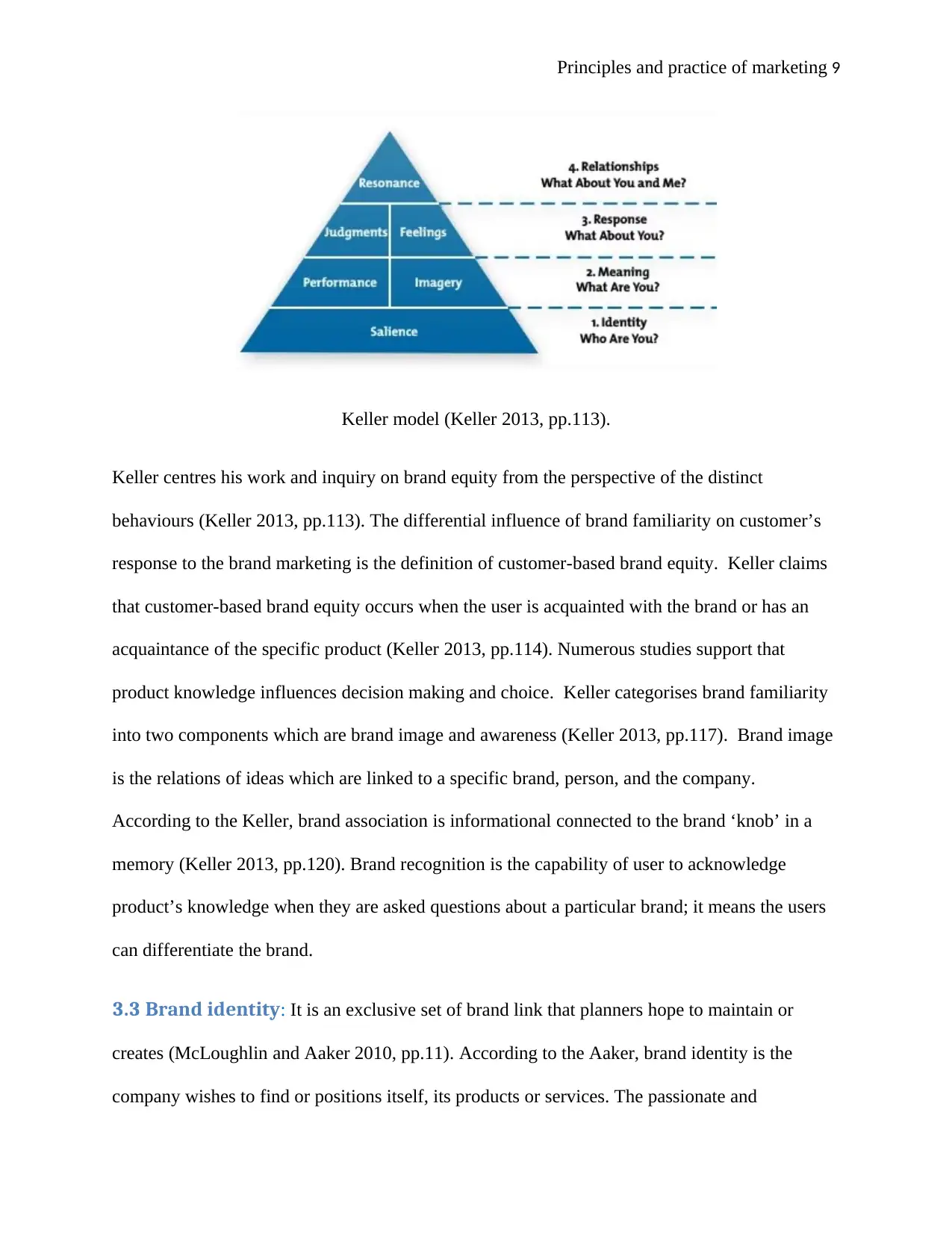
Principles and practice of marketing 9
Keller model (Keller 2013, pp.113).
Keller centres his work and inquiry on brand equity from the perspective of the distinct
behaviours (Keller 2013, pp.113). The differential influence of brand familiarity on customer’s
response to the brand marketing is the definition of customer-based brand equity. Keller claims
that customer-based brand equity occurs when the user is acquainted with the brand or has an
acquaintance of the specific product (Keller 2013, pp.114). Numerous studies support that
product knowledge influences decision making and choice. Keller categorises brand familiarity
into two components which are brand image and awareness (Keller 2013, pp.117). Brand image
is the relations of ideas which are linked to a specific brand, person, and the company.
According to the Keller, brand association is informational connected to the brand ‘knob’ in a
memory (Keller 2013, pp.120). Brand recognition is the capability of user to acknowledge
product’s knowledge when they are asked questions about a particular brand; it means the users
can differentiate the brand.
3.3 Brand identity: It is an exclusive set of brand link that planners hope to maintain or
creates (McLoughlin and Aaker 2010, pp.11). According to the Aaker, brand identity is the
company wishes to find or positions itself, its products or services. The passionate and
Keller model (Keller 2013, pp.113).
Keller centres his work and inquiry on brand equity from the perspective of the distinct
behaviours (Keller 2013, pp.113). The differential influence of brand familiarity on customer’s
response to the brand marketing is the definition of customer-based brand equity. Keller claims
that customer-based brand equity occurs when the user is acquainted with the brand or has an
acquaintance of the specific product (Keller 2013, pp.114). Numerous studies support that
product knowledge influences decision making and choice. Keller categorises brand familiarity
into two components which are brand image and awareness (Keller 2013, pp.117). Brand image
is the relations of ideas which are linked to a specific brand, person, and the company.
According to the Keller, brand association is informational connected to the brand ‘knob’ in a
memory (Keller 2013, pp.120). Brand recognition is the capability of user to acknowledge
product’s knowledge when they are asked questions about a particular brand; it means the users
can differentiate the brand.
3.3 Brand identity: It is an exclusive set of brand link that planners hope to maintain or
creates (McLoughlin and Aaker 2010, pp.11). According to the Aaker, brand identity is the
company wishes to find or positions itself, its products or services. The passionate and
Paraphrase This Document
Need a fresh take? Get an instant paraphrase of this document with our AI Paraphraser
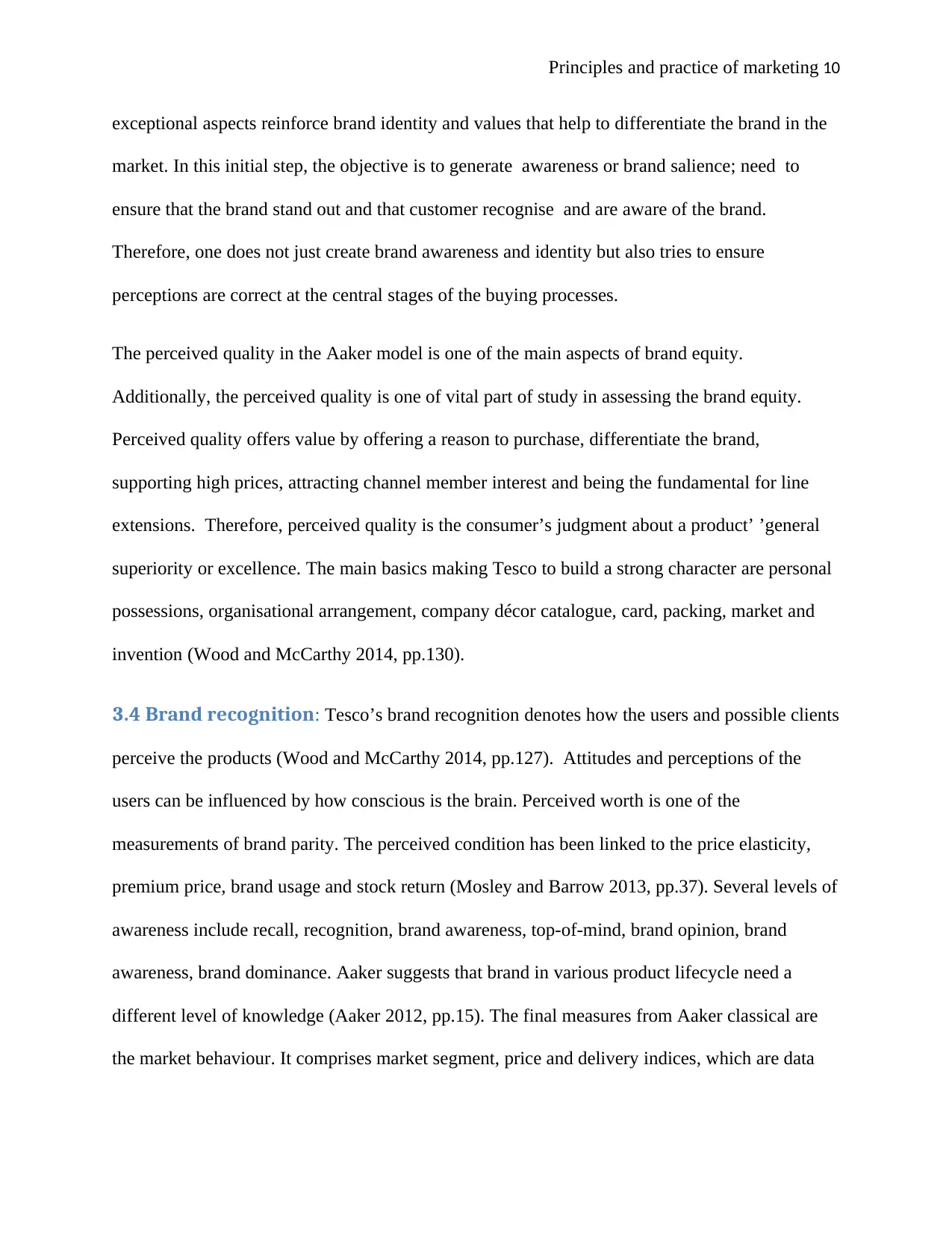
Principles and practice of marketing 10
exceptional aspects reinforce brand identity and values that help to differentiate the brand in the
market. In this initial step, the objective is to generate awareness or brand salience; need to
ensure that the brand stand out and that customer recognise and are aware of the brand.
Therefore, one does not just create brand awareness and identity but also tries to ensure
perceptions are correct at the central stages of the buying processes.
The perceived quality in the Aaker model is one of the main aspects of brand equity.
Additionally, the perceived quality is one of vital part of study in assessing the brand equity.
Perceived quality offers value by offering a reason to purchase, differentiate the brand,
supporting high prices, attracting channel member interest and being the fundamental for line
extensions. Therefore, perceived quality is the consumer’s judgment about a product’ ’general
superiority or excellence. The main basics making Tesco to build a strong character are personal
possessions, organisational arrangement, company décor catalogue, card, packing, market and
invention (Wood and McCarthy 2014, pp.130).
3.4 Brand recognition: Tesco’s brand recognition denotes how the users and possible clients
perceive the products (Wood and McCarthy 2014, pp.127). Attitudes and perceptions of the
users can be influenced by how conscious is the brain. Perceived worth is one of the
measurements of brand parity. The perceived condition has been linked to the price elasticity,
premium price, brand usage and stock return (Mosley and Barrow 2013, pp.37). Several levels of
awareness include recall, recognition, brand awareness, top-of-mind, brand opinion, brand
awareness, brand dominance. Aaker suggests that brand in various product lifecycle need a
different level of knowledge (Aaker 2012, pp.15). The final measures from Aaker classical are
the market behaviour. It comprises market segment, price and delivery indices, which are data
exceptional aspects reinforce brand identity and values that help to differentiate the brand in the
market. In this initial step, the objective is to generate awareness or brand salience; need to
ensure that the brand stand out and that customer recognise and are aware of the brand.
Therefore, one does not just create brand awareness and identity but also tries to ensure
perceptions are correct at the central stages of the buying processes.
The perceived quality in the Aaker model is one of the main aspects of brand equity.
Additionally, the perceived quality is one of vital part of study in assessing the brand equity.
Perceived quality offers value by offering a reason to purchase, differentiate the brand,
supporting high prices, attracting channel member interest and being the fundamental for line
extensions. Therefore, perceived quality is the consumer’s judgment about a product’ ’general
superiority or excellence. The main basics making Tesco to build a strong character are personal
possessions, organisational arrangement, company décor catalogue, card, packing, market and
invention (Wood and McCarthy 2014, pp.130).
3.4 Brand recognition: Tesco’s brand recognition denotes how the users and possible clients
perceive the products (Wood and McCarthy 2014, pp.127). Attitudes and perceptions of the
users can be influenced by how conscious is the brain. Perceived worth is one of the
measurements of brand parity. The perceived condition has been linked to the price elasticity,
premium price, brand usage and stock return (Mosley and Barrow 2013, pp.37). Several levels of
awareness include recall, recognition, brand awareness, top-of-mind, brand opinion, brand
awareness, brand dominance. Aaker suggests that brand in various product lifecycle need a
different level of knowledge (Aaker 2012, pp.15). The final measures from Aaker classical are
the market behaviour. It comprises market segment, price and delivery indices, which are data
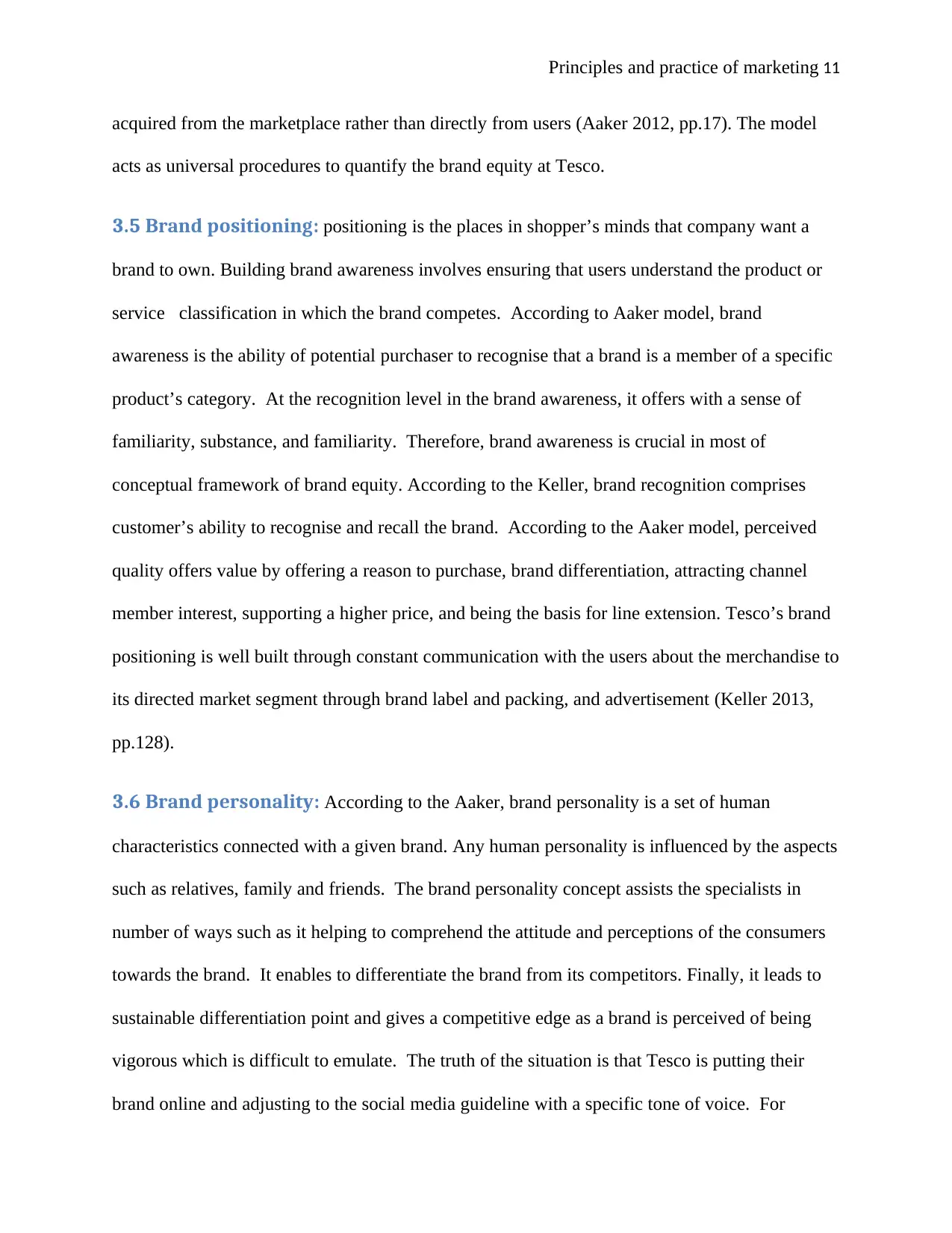
Principles and practice of marketing 11
acquired from the marketplace rather than directly from users (Aaker 2012, pp.17). The model
acts as universal procedures to quantify the brand equity at Tesco.
3.5 Brand positioning: positioning is the places in shopper’s minds that company want a
brand to own. Building brand awareness involves ensuring that users understand the product or
service classification in which the brand competes. According to Aaker model, brand
awareness is the ability of potential purchaser to recognise that a brand is a member of a specific
product’s category. At the recognition level in the brand awareness, it offers with a sense of
familiarity, substance, and familiarity. Therefore, brand awareness is crucial in most of
conceptual framework of brand equity. According to the Keller, brand recognition comprises
customer’s ability to recognise and recall the brand. According to the Aaker model, perceived
quality offers value by offering a reason to purchase, brand differentiation, attracting channel
member interest, supporting a higher price, and being the basis for line extension. Tesco’s brand
positioning is well built through constant communication with the users about the merchandise to
its directed market segment through brand label and packing, and advertisement (Keller 2013,
pp.128).
3.6 Brand personality: According to the Aaker, brand personality is a set of human
characteristics connected with a given brand. Any human personality is influenced by the aspects
such as relatives, family and friends. The brand personality concept assists the specialists in
number of ways such as it helping to comprehend the attitude and perceptions of the consumers
towards the brand. It enables to differentiate the brand from its competitors. Finally, it leads to
sustainable differentiation point and gives a competitive edge as a brand is perceived of being
vigorous which is difficult to emulate. The truth of the situation is that Tesco is putting their
brand online and adjusting to the social media guideline with a specific tone of voice. For
acquired from the marketplace rather than directly from users (Aaker 2012, pp.17). The model
acts as universal procedures to quantify the brand equity at Tesco.
3.5 Brand positioning: positioning is the places in shopper’s minds that company want a
brand to own. Building brand awareness involves ensuring that users understand the product or
service classification in which the brand competes. According to Aaker model, brand
awareness is the ability of potential purchaser to recognise that a brand is a member of a specific
product’s category. At the recognition level in the brand awareness, it offers with a sense of
familiarity, substance, and familiarity. Therefore, brand awareness is crucial in most of
conceptual framework of brand equity. According to the Keller, brand recognition comprises
customer’s ability to recognise and recall the brand. According to the Aaker model, perceived
quality offers value by offering a reason to purchase, brand differentiation, attracting channel
member interest, supporting a higher price, and being the basis for line extension. Tesco’s brand
positioning is well built through constant communication with the users about the merchandise to
its directed market segment through brand label and packing, and advertisement (Keller 2013,
pp.128).
3.6 Brand personality: According to the Aaker, brand personality is a set of human
characteristics connected with a given brand. Any human personality is influenced by the aspects
such as relatives, family and friends. The brand personality concept assists the specialists in
number of ways such as it helping to comprehend the attitude and perceptions of the consumers
towards the brand. It enables to differentiate the brand from its competitors. Finally, it leads to
sustainable differentiation point and gives a competitive edge as a brand is perceived of being
vigorous which is difficult to emulate. The truth of the situation is that Tesco is putting their
brand online and adjusting to the social media guideline with a specific tone of voice. For
⊘ This is a preview!⊘
Do you want full access?
Subscribe today to unlock all pages.

Trusted by 1+ million students worldwide
1 out of 25
Related Documents
Your All-in-One AI-Powered Toolkit for Academic Success.
+13062052269
info@desklib.com
Available 24*7 on WhatsApp / Email
![[object Object]](/_next/static/media/star-bottom.7253800d.svg)
Unlock your academic potential
Copyright © 2020–2025 A2Z Services. All Rights Reserved. Developed and managed by ZUCOL.





